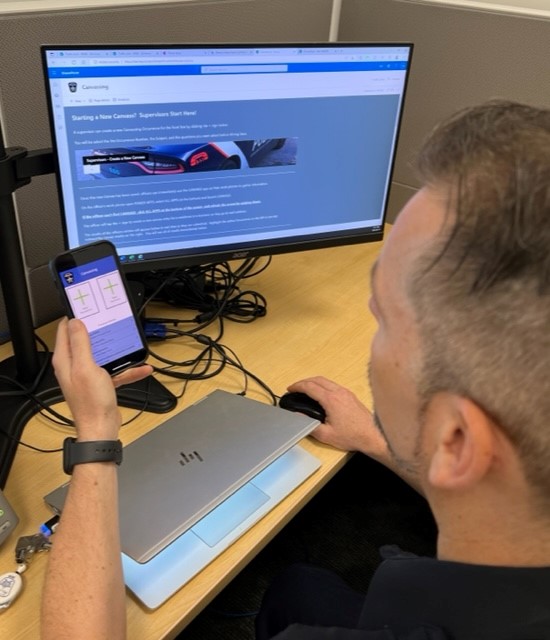
Features
Technology
Using a mobile canvassing application at Barrie Police Service
February 27, 2023 By Curtis Graber and Linda Moorhouse
 Photo credit: Barrie Police Service
Photo credit: Barrie Police Service Most police services are guilty of doing tasks in a certain way simply because it’s the way it’s always been done. One aspect of policing that hasn’t changed in generations is how we canvass the public for information regarding an investigation.
The Barrie Police Service, like most other services, used paper forms to canvass within the community. When a canvass was needed, investigators would brief officers on the questions to ask, the officers would go out and speak to members of the public and then write down the individual’s contact information and their statement. After the officer completed their canvassing duties, they would take the stack of papers and return to the station to deliver it to the investigator. If there was any specific information the officer wanted to point out to the detectives, they would have a conversation about it.
The result was hundreds of paper statements to review and scan, sort and prioritize, and then share with their team through in-person meetings and phone calls. When time is of the essence, this is an inefficient method. Members of the Barrie Police Homicide Unit believed there had to be a better way.
“For major occurrences, it’s vital that the canvass starts right away. If the frontline officer obtains relevant information, it needs to get to the investigators immediately,” explained Det. Kevin Scales. “Paper forms can be difficult to read, they can easily be lost or damaged, and the time it takes from when the statement is taken to when it is delivered to us can be hours later.”
Det. Scales consulted with the service’s Knowledge Management Officer, Cst. Curtis Graber, about upgrading this process. The Barrie Police had recently adopted Microsoft’s Power platform and have successfully used it for several internal and public facing projects that streamline processes to save frontline officers time, while delivering accurate information quickly and consistently.
From the time an investigator creates a canvass sheet, to when officers can start knocking on doors, is a matter of minutes.
Cst. Graber discussed the canvass forms with frontline and homicide officers to determine the priorities. He then used internal and external software to deliver a digitized canvassing solution that has entirely removed paper from the process.
Now, when a canvass is required, any member of the service can create one by entering the occurrence number and what questions they want the officers to ask. Once created, the new canvass is immediately sent out to all officers’ work phones. Using the canvassing app, officers can collect contact information and ask the questions the investigators already created. Officers can use the speech-to-text functionality to transcribe the statement and take photos that are immediately shared with the investigation team.
From the time an investigator creates a canvass sheet, to when officers can start knocking on doors, is a matter of minutes. The investigators can view the results in real time and from any location once the canvass form is saved. The benefits from this savings in time are huge.
The moment the officer saves a canvass, the investigative team can review it to learn if there were any witnesses, if the address has access to security cameras, or if they have any other useful investigative information. They also see which officer submitted the canvass so they can follow up with them immediately if more details are required. If the officer identifies that the person they spoke to should be followed up with an investigation team, the officer can easily flag it on the canvass dashboard. Whomever is monitoring the dashboard will see the flag and act on it immediately, rather than having to wait for the officer to return to the station.
This new canvass application was put into operation just a few weeks after it was created, for a homicide investigation. Frontline officers began collecting information within an hour of the call that occurred in the middle of the night. As the investigative team arrived, they could immediately get to work and process the information being gathered. They saw what addresses needed attention and had contact information for witnesses that needed to be re-interviewed.
Through the elimination of the time-consuming paper canvass form, information gathering is quick, accurate and specific to the investigation. Further, there are no issues with the legibility of an officer’s handwriting. Information is passed along and acted upon in real time, and that is crucial for serious crimes.
“The real beauty of the Microsoft Platform is that this went from a high-level idea, to being in production within a few weeks and without any developers,” said Cst. Graber. “Shortly after this successful use, word quickly spread and other police agencies began contacting me wanting a similar solution for their teams. I was able to package it up and provide it to them so they can see the same benefits we have. When you consider the number of paper-heavy and repetitive routines we do as a police service, I think we’re only just getting started.”
Cst. Curtis Graber is in his 8th year with Barrie Police Service and has a strong interest in developing software applications to enhance law enforcement practices.
S/Sgt. Linda Moorhouse is in her 28th year with Barrie Police Service and is currently assigned to Executive Services, overseeing Strategic Business Planning, Diversity and Inclusion, Fleet and Grants.
Print this page